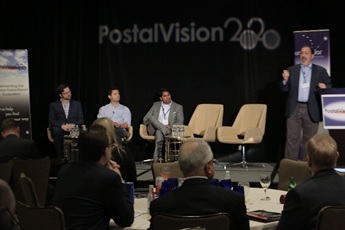The Circular Economy of Returns at PostalVision 2020
By Kathleen Siviter, Ursa Major
Tony Sciarrotta, Executive Director, The Reverse Logistics Association (RLA) kicked off and moderated a panel discussing returns at the recent PostalVision 2020 event held just outside Washington DC. RLA has participated in several PostalVision events over the last few years, including partnering with PostalVision to host a one-day event held in the fall of 2018 at George Mason University in Arlington, VA. 
The Circular Economy and Returns panel at the 2019 PostalVision event included Ravin Mangal, Director, Product Management, Shipping, U.S. Postal Service (USPS); Dan Nevin, CEO, North America, Doddle; and Dr. Ian Stanford, Public Policy Analyst, USPS Office of Inspector General (OIG).
 Sciarrotta presented an overview of the explosive growth of the secondary market and returns. The returns rate for purchases at brick and mortar retail stores is 8.9% vs. a 30% returns rate for ecommerce purchases. The size of the U.S. secondary market has doubled since 2008, to $618 billion. In response to survey, 40% of firms said their secondary market sales have increased significantly in the U.S. over the past 5 years. Sales revenues for the largest “value retailer” chains are up 71% since 2008 – Dollar Stores has seen 92% growth in secondary market revenue since 2008.
Sciarrotta presented an overview of the explosive growth of the secondary market and returns. The returns rate for purchases at brick and mortar retail stores is 8.9% vs. a 30% returns rate for ecommerce purchases. The size of the U.S. secondary market has doubled since 2008, to $618 billion. In response to survey, 40% of firms said their secondary market sales have increased significantly in the U.S. over the past 5 years. Sales revenues for the largest “value retailer” chains are up 71% since 2008 – Dollar Stores has seen 92% growth in secondary market revenue since 2008.
Dr. Stanford talked about the “threat and opportunities” presented by the growth of returns. He noted that integration is being seen in whole systems that run from the customer, through integrators,  through third party sellers and all in the supply chain. But there are two significant problems seen with returns, he said, the increasing costs and logistics nightmare and customer demands for fast, free and convenient returns solutions. Shipping is still the dominant way people initiate ecommerce returns, but 74% of those responding to a 2018 Narvar Consumer Report said they shipped back their returns, and 40% of those said they think returning in store is easier and would do it that way if available.
through third party sellers and all in the supply chain. But there are two significant problems seen with returns, he said, the increasing costs and logistics nightmare and customer demands for fast, free and convenient returns solutions. Shipping is still the dominant way people initiate ecommerce returns, but 74% of those responding to a 2018 Narvar Consumer Report said they shipped back their returns, and 40% of those said they think returning in store is easier and would do it that way if available.
So why does shipping not always meet the customer’s needs? The customer wants to return an item and be made whole as quickly as possible (refund, replace item). There typically is a gap in time between mailing the return and obtaining the refund/replacement. In addition, doing returns is not user-friendly and usually involves packing and access to a carrier network.
To ease these customer concerns, we are now seeing the “era of the omnichannel partnership,” Stanford said, with partnerships for returns between companies like Kohls/Amazon and FedEx/Walgreens and models that increase and facilitate consumer access points like UPS Access Point, and Happy Returns. Others are working toward improving other returns channels like BORIS (Buy Online Return In Store), parcel lockers or package pickup options.
There are advantages to some of these alternative omnichannel models, Stanford said, such as increasing the in-store foot traffic and creating crossover purchasing opportunities, one-stop shopping experiences, and increased customer satisfaction and loyalty. And does a strong omnichannel returns strategy result in fewer returns shipped by mail?
For customers, it’s all about convenience, Stanford said, and the USPS should consider targeting/segmenting returns solutions by products likely to be returned, improve the in-person experience in post offices, consider alternatives to post offices, and consider specific retail partnerships.
The USPS OIG has published two papers to date looking at returns and reverse logistics: “Riding the Returns Wave: Reverse Logistics and the U.S. Postal Service,” (April 2018); and (August 2016). It plans to publish a new piece of work on Cross-Border Returns in late 2019.
 Dan Nevin, North America CEO, said Doddle focuses on helping improve delivery and returns for retailers and their customers. Their research shows that for ecommerce returns 56% of survey respondents said the worst thing about online shopping is the hassle of returns and 38.5% said paying for returns. So how do you turn returns into a positive customer experience?
Dan Nevin, North America CEO, said Doddle focuses on helping improve delivery and returns for retailers and their customers. Their research shows that for ecommerce returns 56% of survey respondents said the worst thing about online shopping is the hassle of returns and 38.5% said paying for returns. So how do you turn returns into a positive customer experience?
Doddle provides a self-service returns kiosk that customers can use for no cost to them, no printing labels required, and no waiting in line. The Doddle Pudo Network has thousands of locations to consolidate returns as well as ecommerce shipments for pick up by customers at the retailer location. Doddle also offers a way to donate returns directly to Goodwill, consolidating to reduce costs.
Ravin Mangin, USPS, said that ecommerce has exploded over the past few years and is poised for continued growth. According to multiple sources, ecommerce will have grown over 15% between 2010 and 2020, to over $684 billion in retail sales. Ravin said the USPS saw nearly a 20% increase in the volume of returns parcels it handled from its Fiscal Year 2017 to 2018, up to 178 million for FY2018 (10/1/17-9/30/18). He said the USPS is projecting a 19.6% increase in returns during this coming 2019 holiday peak season over what it saw last holiday season.
and 2020, to over $684 billion in retail sales. Ravin said the USPS saw nearly a 20% increase in the volume of returns parcels it handled from its Fiscal Year 2017 to 2018, up to 178 million for FY2018 (10/1/17-9/30/18). He said the USPS is projecting a 19.6% increase in returns during this coming 2019 holiday peak season over what it saw last holiday season.
The USPS is working on several initiatives and solutions for the returns market, Ravin said, including a retail label broker that allows a customer to print a label at the post office using a QR code on their mobile device, as well as self-service kiosks for dropping returns and other parcels. The USPS also is exploring a package-less returns option where customers can bring items unpackaged to the post office for return, and has introduced several different returns shipping options.
 Kathleen Siviter
Kathleen SiviterKathleen J. Siviter is Director,
Community and Brand Development,
for PostalVision2020, a Washington, DCbased
think-tank initiative designed to
serve as an independent transformative
group that inspires imaginative thinking,
stimulates provocative conversation,
and influences the reinvention of the
global logistics/delivery/postal industry of the future.
Since 2011, PostalVision has held an annual event
in the Washington DC area that brings together
thought leaders, policy makers, entrepreneurs/startups,
global supply chain representatives, innovators,
futurists, disruptors, and businesses in the global
logistics, delivery, and postal ecosystem.